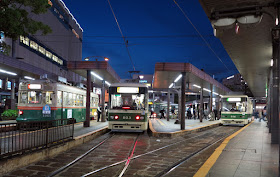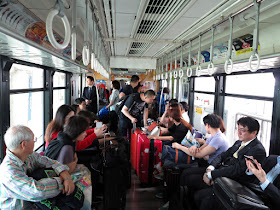For any urban rail enthusiat, Hiroshima
is certainly one of the highlights of a Japan tour. Here you can find
the country's largest "Streetcar" system, but also a
single-line metro-style guided transit system.
Evening parade of older trams at the railway station terminal
Hiroden
Let's start with the trams as this is
what you see first when arriving in Hiroshima by train. My first
impression was, it feels like Melbourne, old and new trams entering a
restricted terminus one after the other and hurrying to leave again
to let the next cars arrive. The terminus actually has three stub
tracks, but rather short ones, dating from the period when only short
trams were used. Line 5 enters the northern track (the one closest to
the station building) and also accepts passengers there. Lines 1, 2
and 6, however, use the other two stubs to drop off passengers (with
a mobile fare collector helping on the platform), but they pick up
passengers at a point further east (where line 5 also has to pass
through without stopping). With lots of tourists coming to Hiroshima
especially for the atomic bomb memorial sites, this is a busy tram
terminal at all times.
Paris-style livery on Hiroshima's long low-floor trams
Japanese product for lines with less demand
But before we can board a tram we need
to get a ticket, and here's good news for all foreign visitors: at
the information desk at the tram terminal you can get a 3-day pass
for just 1000 Yen (8 EUR), while a normal day pass for the tram would
cost 600 Yen. The tourist pass also includes buses and the ferry from
the end of tram line 2 to the Miyajima Island, a popular tourist
destination. But it does not cover JR trains or the Astram Line (see
below). For normal people, the tram, which is known as Hiroden
(Hiroshima Electric Railway), there is actually a flat fare within
the city of 160 Yen per ride (American-style transfer tickets are
handed out on exiting), just line 2 beyond Nishi-Hiroshima has an
additional fare. The biggest problem with fares in Hiroshima is the
way it is collected. On older trams, you are supposed to enter
through the rear doors (tapping in with IC Cards, and exit at the
front by showing your ticket to the driver, paying the cash fare or
tapping out. The problem arises when the trams get too full, and they
do. So anybody getting off at one of the intermediate stops has to
squeeze through the crowds to make their way to the front and get
off. A very unpleasant and actually stupid procedure, in Europe I
think only known in Amsterdam. But with the honesty of the Japanese
and a few random inspections it should be possible to introduce a
sort of honour system so that all doors can be used to get on and
off. The situation is slightly better on the new multi-articulated
trams because they have a conductor at the rear, so you can choose
whether to move forward or backward in order to exit.
Typical super-narrow platforms
The Melbourne feel of the system is
also apparent in the tram stops, of which there are plenty, maybe too
many for example on the main east-west route. Most of them have
platforms, hardly any boarding from street level, but those platforms are
mostly so narrow, they would be considered dangerous in other parts
of the world. Hardly two people can stand next to each other, which
causes some sort of congestion with passengers getting off, those
getting on, and those waiting for another tram obstructing the
platform anyway. Otherwise the stops have all necessary information
panels, the name is written in big letters, and what's best, like on
Japanese metro systems, the stops are numbered, which is quite useful
for foreigners, and also helps to classify the photos. As a trunk
route, M1 to M39 (M for Miyajima) corresponds to line 2, other routes
carry a letter for the area they run through or to, Y for Yokogawa,
etc. Most tourists could thus take a direct line 2 tram from M1
(Railway station) to M10 (Atomic Bomb Dome). There are 8 lines, and
these are shown properly in different colours on the abundant maps.
The line colour is also used on some next-tram indicators.
Older articulated high-floor tram mostly running on line 2
Modern colour indicators at some stops
Typical information panel at stops
Although they call the system
"Streetcar" in English and although it runs on street
level, it generally has its own lanes, so the trams don't get stuck
in traffic jams, but still offer a rather low average speed mainly
because of rather long traffic light cycles (a feature I had also
observed in Australia). So although they actually travel fast where
possible, they often stop for a long time, there is no traffic light
preemption. The condition of the track is rather reminiscent of some
Eastern European tram systems, it is still operable, but could do
with a complete renewal in many places. The tram fleet has already
been renewed, but you can still see some of the very old vehicles,
not yet branded as a special tourist attraction, but probably soon.
Inbound Combino at Nishi Hiroshima, end of urban section
The Siemens Combinos are mostly on line 2 mixed with older high-floor
articulated trams, and they run quite smoothly on the long interurban
line, which has a railway-type alignment. The other long low-floor
tram is a Japanese product, although it appears to be a copy of a
Paris Citadis, even the RATP corporate colours are included. Then
there are shorter Piccolos, which look like Pesa trams, so quite a
variety. Some of the older high-floor articulated vehicles have been
refurbished and now carry a "Green Liner" logo, so they
will remain in service for some time still. In addition to the
air-conditioning, the trams also have blinds, which is certainly good
when the sun is too strong, but which obstructs the curious visitor's
view...
Rubber-tyred metro system
Astram
Besides the relatively large tram
system, Hiroshima also has one metro line, the so-called Astram,
which technologically is similar to the Yurikamome in Tokyo in that
it is a guided transit system on rubber-tyres, but unlike Tokyo's, it
is manually driven. I explored it on a Sunday afternoon, so I can't
tell you much about its normal usage. When I was there, it was not
too busy, with trains running every 10 minutes, and only every 20
minutes on the outer stretch. The problem with Astram is that it is
not very useful for short inner-city trips, maybe a bit more since
the Shin-Hakushima station was added last year as this provides
interchange with the busy JR Sanyo Line (yes, this line was even busy
in the outbound direction on a Sunday morning!). So JR passengers can
now avoid the overcrowded trams from Hiroshima station into the city
centre. Otherwise, Astram just connects the city centre to the
northern suburbs, so I assume that it does get crowded in peak hours,
but is not too busy during off-peak.
Astram viaduct beyond the outer terminus
Now that I have also seen a few
monorail systems, I don't really see the advantages of such a
rubber-tyred train, especially when a driver is used. The ride is
certainly not smoother than on monorails, rather worse, a bit like a
bus running on a motorway, with gentle sections, but then also a lot
of humps. But compared to, for example, the Kitakyushu Monorail,
Astram's viaduct is much more substantial, i.e. construction costs
must be much higher and the visual impact is much stronger, as the
elevated structure is just the same you would need for a proper
metro.
Funnily, the otherwise rather basic
stations, are colour-coded, on line diagrams and within the station
itself. What you see from the train, however, are just orange doors!
This is rather absurd, as colour-coding was originally (some 100
years ago...) meant to help passengers identify their station, but
this is not the case here. But it would be the easiest of all
possible improvements to paint the platform screen doors outside in
the same colour as inside! And while they are at it, they could
choose stronger colours anyway:
Ushita - typical Astram station, here in turquoise-blue
Pink is the colour for the Hondori terminus in the city centre
The original three underground stations
are not bad, each in a different colour, too, but all a bit small.
The most spectacular station is certain the newly added
Shin-Hakushima with its high vaulted roof (the station is located
below the surface, but somehow daylight comes down to the platform).
The platform edges form a V, as the tracks diverge heading north
towards the ramp under the JR railway viaduct.
Shin-Hakushima, a station added in 2015 to provide interchange with JR services
The trains also boast a strong orange
on the outside, inside they are a bit pale with grey upholstered
longitudinal seats (some have apparently been refurbished recently),
making them appear a bit old-fashioned. The four cars are
interconnected, but just with a rather narrow gangway:
Farewise, Astram is one of the bizarre
cases of Japanese transport systems. While a day pass for the entire
tram system is just 600 Yen, that for Astram alone costs 930 Yen! But
considering that a trip from end to end (18.4 km) already costs 480
Yen, it's not that bad for a real rail enthusiats... Or get on at
Hondori, ride the entire line to the end and back to Kencho-mae
without getting outside for a photo, you may only be charged 190 Yen!
Still in the Hiroshima area, there is a
funny cable suspension railway, i.e. hauled by a continuous cable
which the cabins grip on to, it climbs from JR Seno station like the
wrongly-named Chiba Monorail (actually a suspension railway) to a
nice residential area. Biggest problem here, the system does not
accept IC Cards from other places and the ticket machine does not
speak English! So I pressed the HELP button, and said "Can I buy
a ticket", so they called the ticket office next to me to wake
up the station clerk who had apparently been resting behind a folding
screen (I could have shouted, but thought it would be unpolite), so
he came out and helped me to get a 160 Yen ticket for a fun-ride up.
Down, I managed to get a ticket by myself... The ride itself provides a nice view, but the technology is not convincing, shaking a lot, actually a proper aerial cable car swings more pleasantly.
Previous Stop: KITAKYUSHU | Next Stop: KOBE
LINKS
Hiroden (Hiroshima Electric Railway)
Hiroshima at UrbanRail.Net (feat. map)

















































